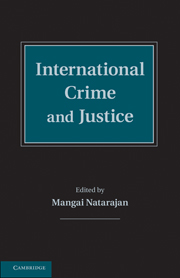Book contents
- Frontmatter
- Contents
- List of Figures
- List of Tables
- List of Contributors
- Foreword
- Preface
- Introduction
- Part I International Criminology
- Part II Law, Punishment, and Crime Control Philosophies of the World
- Part III Transnational Crime
- Part IV Organized Crime and Terrorism
- Part V International crime
- Part VI Delivering International Justice
- Part VII International Cooperation and Criminal Justice
- Part VIII International Research and Crime Statistics
- Part IX International research resources
- World Map
- Index
Part IV - Organized Crime and Terrorism
Published online by Cambridge University Press: 05 October 2014
- Frontmatter
- Contents
- List of Figures
- List of Tables
- List of Contributors
- Foreword
- Preface
- Introduction
- Part I International Criminology
- Part II Law, Punishment, and Crime Control Philosophies of the World
- Part III Transnational Crime
- Part IV Organized Crime and Terrorism
- Part V International crime
- Part VI Delivering International Justice
- Part VII International Cooperation and Criminal Justice
- Part VIII International Research and Crime Statistics
- Part IX International research resources
- World Map
- Index
Summary
Organized crime is usually thought of as being committed by highly organized, professional criminals exemplified by the Italian Mafia (see Vincenzo Ruggiero’s description of the Italian Mafia in Chapter 33). Chapters in this section provide a wealth of information about similar criminal organizations from the various regions of the world, including Balkan organized crime groups (Chapter 31 by Jana Arsvoska), Russian organized crime groups (Chapter 32 by Jim Finkenauer, Alexander Sukharenko and Eric Lesneskie), Asian organized crime groups (Chapter 35 by Leona Lee), and Columbian drug enterprises (Chapter 36 by Desmond Arias). In many ways, terrorist groups are similarly organized and this section contains two chapters on terrorism (Chapter 37 by William Parkin, Joshua Freilich, and Steven Chermak and Chapter 38 by Graeme Newman and Ronald Clarke). Organized crime groups, like the Italian Mafia, are generally portrayed as being involved in a wide variety of different criminal enterprises, such as drug dealing, smuggling, extortion (see Chapter 34 by Ernesto Savona and Marco Zanella), prostitution, and so forth. It is widely assumed that if police operations close of any of these sources of income, the organization switches resources to one of its other enterprises, or finds a new avenue for illegal profit. This is why police have tried to take out these organizations and why the United Nations has devoted so much effort to coordinating international efforts to eradicate these groups. The UN work culminated in 2000 with the adoption of the Palermo Convention, which formalized international agreements to deal with transnational crime syndicates and to harmonize the necessary legal requirements.
However, recent research is putting forward a quite different view of organized crime. Instead of consisting of a few, highly structured, semipermanent organizations formed to conduct criminal business, researchers are now suggesting that organized crime consists of a much larger number of small, criminal enterprises, often transitory in nature, that develop to exploit particular opportunities for illegal profit. This new picture of organized crime is reinforced by the results of research on transnational crime, including money laundering, trafficking in women and stolen cars, and counterfeiting of currency and high value products. Consistent with routine activity theory, these new forms of organized crime have emerged in response to new opportunities for criminal profit resulting from increased globalization and technological development.
- Type
- Chapter
- Information
- International Crime and Justice , pp. 229 - 230Publisher: Cambridge University PressPrint publication year: 2010

